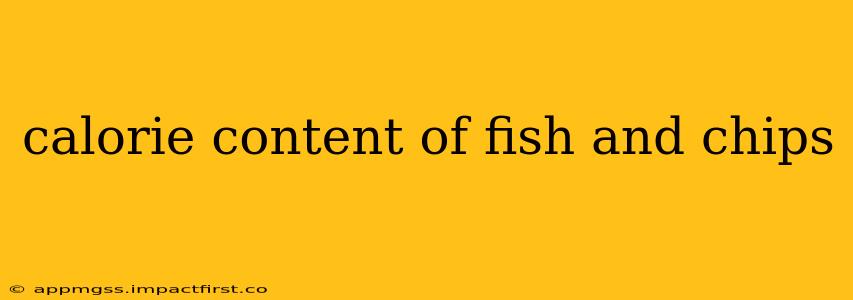Fish and chips, a beloved British takeaway, is a delicious indulgence, but it's important to be mindful of its calorie content. The calorie count can vary wildly depending on the portion size, type of fish, batter recipe, and even the type of oil used for frying. This comprehensive guide will delve into the factors affecting the calorie count of your fish and chips and help you make informed choices.
What are the average calories in fish and chips?
A typical serving of fish and chips (one medium-sized fish and a portion of chips) can range anywhere from 700 to 1200 calories. This wide range highlights the significant impact of the variables mentioned above. A smaller portion, lighter batter, and baked instead of fried options can significantly reduce the calorie intake.
How many calories are in a single portion of fish?
The calorie count of the fish itself is considerably lower than the chips. A single portion of cod, for example, might contain around 200-300 calories, depending on the size. Other white fish like haddock or plaice will have a similar calorie range. The batter, however, adds a substantial number of calories.
How many calories are in a single portion of chips?
A regular portion of chips can easily contain 400-600 calories or more. The type of potato, the amount of oil absorbed during frying, and the portion size all significantly contribute to this calorie count. Thick-cut chips generally have a higher calorie content than thin-cut chips.
What factors affect the calorie content of fish and chips?
Several factors influence the final calorie count of your fish and chips:
- Type of Fish: Different fish varieties have varying fat and calorie contents. Oilier fish like salmon will naturally have a higher calorie count than leaner options like cod or haddock.
- Batter Thickness and Type: Thicker batters contribute significantly to the overall calorie count. The type of batter (e.g., beer batter vs. standard batter) can also affect the calories.
- Frying Method and Oil: Deep frying in oil like vegetable or sunflower oil contributes significantly to the calorie content, as the food absorbs the oil during cooking. Baking or air frying can be healthier alternatives.
- Portion Size: Larger portions naturally have higher calorie counts. Opting for a smaller portion can significantly reduce your overall calorie intake.
- Added Salt: While salt itself doesn't contain calories, excess salt can lead to increased water retention, which can temporarily inflate the weight and therefore, perceived calorie count.
Are there healthier options for fish and chips?
Yes, there are ways to enjoy fish and chips while being more mindful of your calorie intake. Consider these options:
- Baked or Air-fried Fish and Chips: Baking or air frying significantly reduces the amount of oil absorbed, resulting in lower calorie counts.
- Smaller Portions: Choose smaller portions of both fish and chips to reduce your overall calorie intake.
- Healthier Batter: Opt for lighter batters or even consider alternatives like breadcrumbs.
- Skinless Fish: Removing the skin from the fish slightly reduces the calorie and fat content.
How can I track the calories in my fish and chips?
Many restaurants and takeaways now provide nutritional information, including calorie counts, on their websites or menus. You can also use calorie-counting apps to estimate the calorie content based on the ingredients and portion sizes. However, it is always best to make an estimate rather than rely on exact numbers due to variations in preparation.
By understanding the various factors that influence the calorie content of fish and chips, you can make more informed choices and enjoy this classic dish in a more balanced way. Remember that moderation is key – enjoying fish and chips occasionally as part of a varied diet is perfectly fine.
